Back Extension Exercises
Table of Contents
Introduction
- Performing the back extension exercise will increase your ability to coordinate movement through your low back. Other improvements include a strong back and a back that has more endurance. Overall, Back exercise leads to better overall back posture, important for the prevention of back injury.
- Lumbar extensors are mainly composed of the erector spinae and multifidus groups of the muscle, and work cooperatively with gluteal and hamstring muscles during the extension of the trunk.
- Back extension exercise includes two types of exercise
- Strengthening exercise
- Stretching exercise
Benefits of the back extension exercise
Compared to other exercises thought to target the muscles of the back, the back extension provides more benefits to the back muscles. Extension exercises are more isolated and primarily involved in strengthening the back. The benefits of back extension muscles exercises are:
- Reduces low back pain: back extension exercises target the lower back or the lumbar area of the body. Because exercise reduced low back pain, it makes sense that extension exercises that locally affect the spine are a good way to ease back pain. Extension exercises are a good way to stretch and strengthen your lower back.
- Strengthening posterior chain: The extension exercise activates and works most posterior chain muscles from the erector spinae to the glutes, and hamstrings muscles.
- Improves hip extension: The ability to engage the back muscles during the exercise of the back extension rests on the power of the hip to flex and extend. The activity is therefore not only great for your back but also improves your hip’s range of motion(ROM).
- Better core strength: Back muscle exercises are the perfect addition to your core-training bro split as it perfectly complement core exercises at all times. It does this by correcting any rounding in your back, strengthening, and stretching it out. This prepares you for more challenging routines in the gym like deadlifts.
- Improve posture: With many gym-goers whose daily life revolves around awkwardly bending over desks and their phones, this often leads to bad posture. This may be evident in the rounding of their shoulders, their neck, their walk, and even often at the gym. Although training your core is one way of correcting posture, the fact remains that your back bears most of your body weight. Training your back with extension exercises is a good way to improve and maintain good posture.
- Stronger back: The back helps you to pull, lift, and carry. This is a lot of work for weak and small muscles in the back. Back extension exercises will help to correct any lag and imbalances in the back.
Strengthening exercise
Beginner back extension exercise
- Strengthening the back muscles can help significantly reduce the occurrence of osteoporosis-related compression fractures.
- This exercise calls for you to bend your spine back.
- Lie flat on your stomach with your forearms on the floor next to you, tucked in close to your sides.
- Raise your chest off the floor while keeping your hips, legs, and feet relaxed and in contact with the floor. Your elbows should be the same level as your shoulders.
- Hold this position for 5 seconds before gently lowering yourself back to the floor.
- Work gradually up to 30 seconds.
- Aim to complete 10 repetitions.
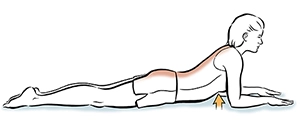
the slightly more advanced form of the strengthening exercise
Here’s a slightly more advanced form of the press-up exercise than the previous
- Lie face down on your stomach and place your hands on the floor next to you, about level with the bottom of your ribcage (push-up position).
- Push through your arms, straightening your elbows. Lift the top half of your body off the floor while your lower body remains pressed against the floor.
- Arch or sag your back and try to relax the lower part of your body.
- This position is typically held for 1 to 2 seconds and then repeated 10 times.

Superman exercise
Superman Exercise – Starting Position
- Lay on the floor with your arms stretched out in a “V” position. Support your head with a small rolled-up towel to maintain a neutral spine, and keep your chin tucked slightly.
- You can lie on the floor or on the bed. If you are on the bed, you may need a pillow under your stomach for extra support and comfort.
Superman Exercise – Legs
- Raise one leg at a time while being sure to keep your core muscles active. Don’t arch your back. Raise your leg up 4 to 6 inches if you can. If you start to twist in the trunk or the lower back, then stop. Only raise the leg as much as you can without twisting.
- Perform two sets of 10 repetitions, 1 to 2 times a day.
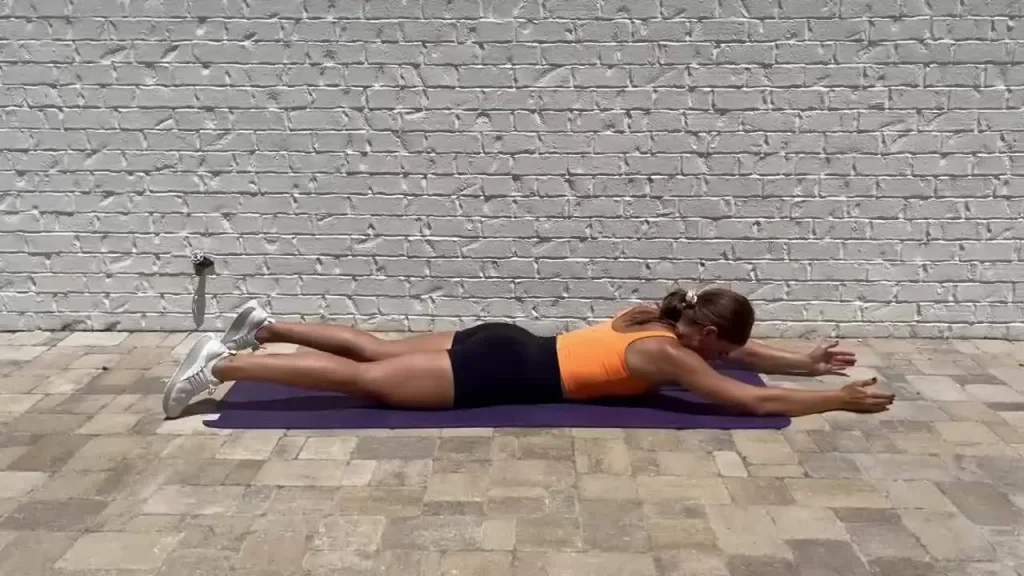
Superman Exercise – Arms and Legs (Opposite)
- Raise your opposite arm and leg. You have to keep your core muscles active. Don’t arch your back. Raise your leg up 4 to 6 inches if you can. If you start to twist in the trunk or the lower back, then stop. Only raise the leg as much as you can without twisting. Be sure to keep your chin tucked slightly in and in a neutral position. Keep your shoulder blades back and down. Don’t shrug.
- Perform two sets of 10 repetitions, 1 to 2 times a day.
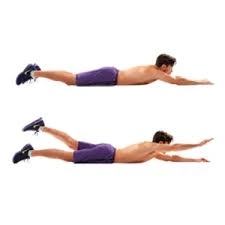
Superman Exercise – Arms and Legs (Opposite)
Superman Exercise – Arms and Legs (t the Same Time)
- Raise your arms and legs. You have to keep your core muscles active. Don’t over arch your back. Raise your legs up 4 to 6 inches if you can. As your head elevates, be sure to keep your chin slightly tucked in and in a neutral position. Keep your shoulder blades back and down. Perform one set of 5 repetitions. Hold each repetition for 30 seconds, 1 to 2 times a day.
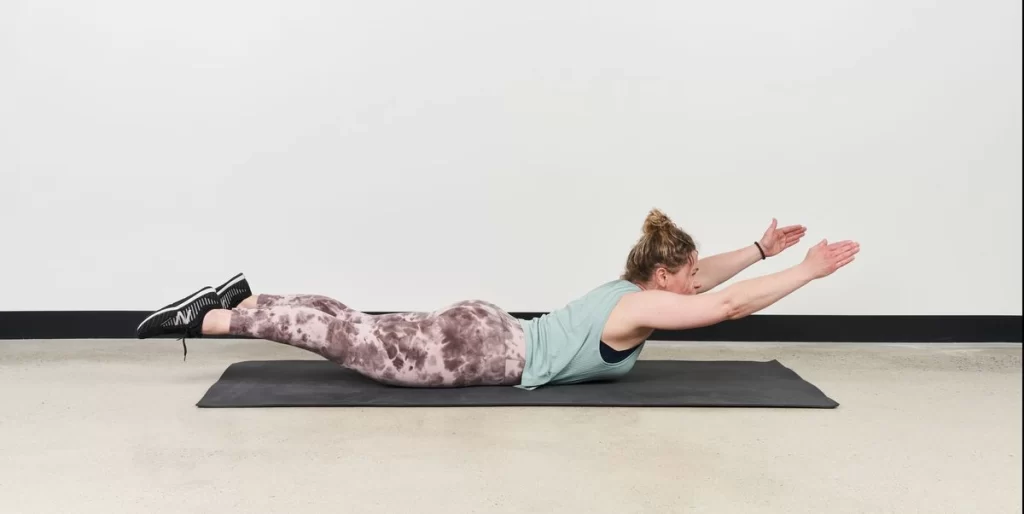
Ball Extension
- Ball Extension – Starting Position
- Position your feet against the wall to assist you with your balance. Your legs stay straight. You have to keep your chin down in a neutral position and your hands crossed behind your head. You can cross your arms over your chest to make it easier for you. For more of the challenge, stretch both of your arms into the “V” position (as shown in the superman exercise).
- From your initial position, slowly raise your upper body until you have a slight arch in your back. Keep the movement pain-free.
- Perform two sets of 15 to 20 repetitions, 1 to 2 times a day
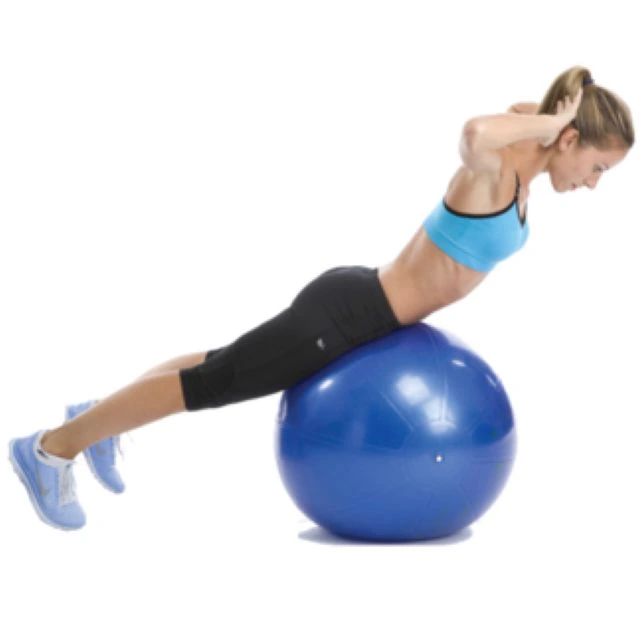
advanced extensions exercise
Here is an advanced extensions exercise that targets your muscles of the upper back :
- Lie face down on your belly with a pillow tucked under your hips.
- Extend your arms back. You might want to clasp together your hands behind your lower back.
- Then raise your head and chest up from the floor.
- Hold this position for 5 seconds while looking at the floor.
- Gradually work up to 20 seconds at a time. Aim to complete 10 to 12 repetitions of this exercise.
- One modification of the advanced extensions exercises instructs you to lift your legs off the floor as well. A doctor or physical therapist could help you find the variation that works best for you.
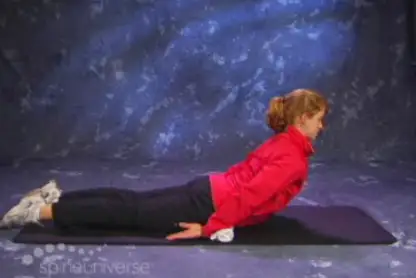
Table Top
- Start in the ‘tabletop position.
- Gently draw in your lower stomach muscles to activate your abdominal muscles.
- It is very good to imagine that you are keeping a tray on your back with a glass of water that you wish to balance.
- Gently lift your one arm whilst maintaining your balance. If that feels easy, then you can repeat this with your eyes closed.
- Alternate arm lifts.
- Check that your lower stomach muscle contraction is well maintained.
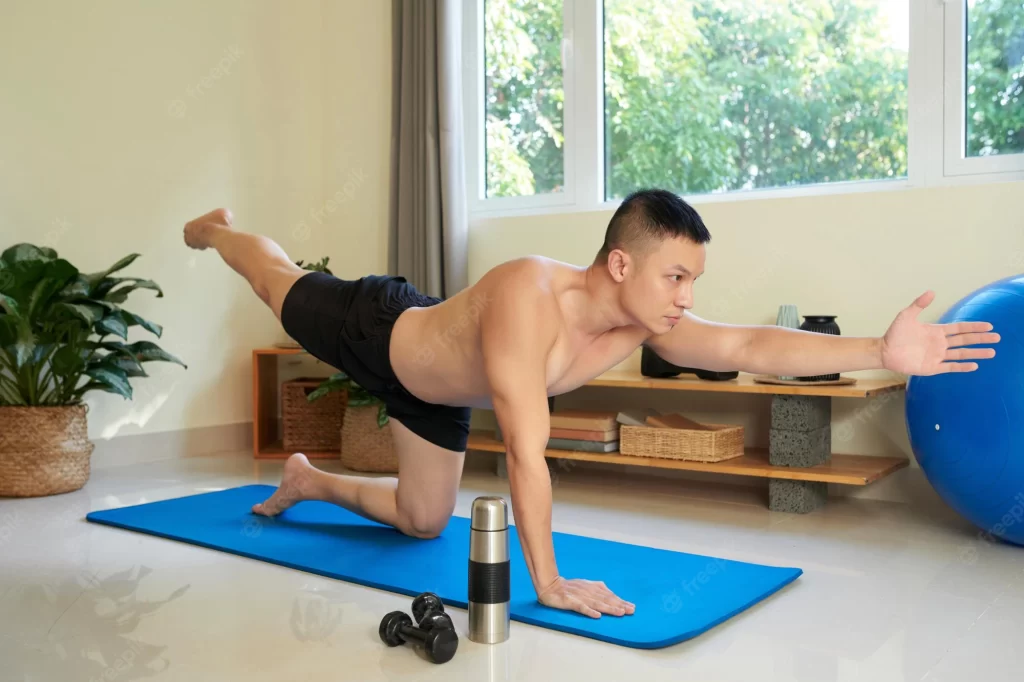
Bridge Curl
- Lie on your back with knees flexed and feet hip-width apart.
- Slowly and gently lift the spine off the ground one vertebra at a time.
- Slowly lower the spine back to the ground, again one vertebra at a time.
- If your core muscles are weak, the movement can feel ‘jerky’. Over time, the movement will become more smooth.
- Repeat the movement 5 times.
- Repeat 10 times.
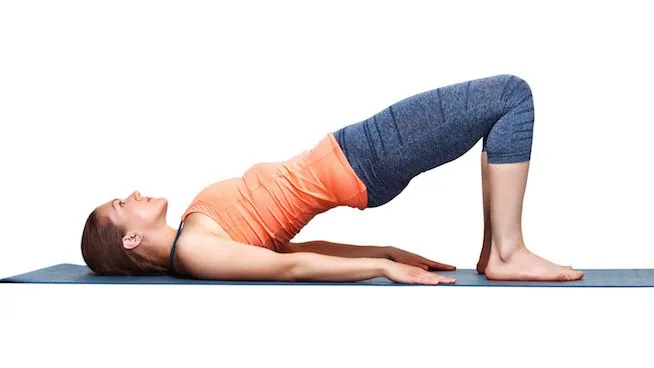
Stretching exercise
Knee-to-chest stretches
Knee-to-chest stretches can help elongate the lower back muscles, relieving tension and pain in the muscle.
A person can perform the knee-to-chest stretch as follows:
- Step 1: Lie on the back with both legs flat against the ground.
- Step 2: Lift the right leg, bending the knee toward your chest.
- Step 3: Use both hands to pull the right knee toward your chest.
- Step 4: Hold the right knee against the chest for some seconds.
- Step 5: Return to the starting position.
- Step 6: Repeat with the left leg and then return to the beginning position.

Kneeling back stretch
The kneeling back extension can help to stretch the lower back muscles and reduce pain and tension in these areas.
To perform the kneeling back stretch exercise, a person can follow these steps:
- Step 1: Begin the exercise on the hands and knees, positioning the knees hip-width apart, with the shoulders directly over your hands.
- Step 2: Round the back, pulling the belly button up toward the spine and tilting the lower back toward the ground.
- Step 3: You can hold this position for 5 seconds.
- Step 4: Rock gently backward, lowering your buttock as close as possible to the heels. Ensure that the arms are well stretched out in front.
- Step 5: You can hold this position for 5 seconds.
- Step 6: Rock gently backs up to the initial position. Repeat 10 to 15 times.
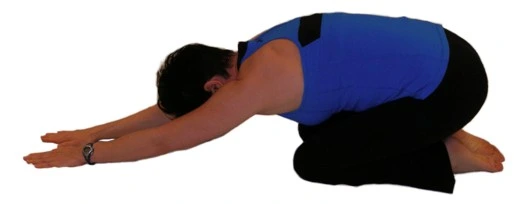
Modified seated side straddle
The seated side straddle exercise stretches the hamstring, the abductors, and the extensor muscles of the middle and lower back. The seated side straddle requires a person to follow the following steps:
- Step 1: Sit with both legs flat against the ground and extended out in front of the body. Make sure the feet should be far enough apart that the legs form a “V” shape.
- Step 2: Bend the left leg, bringing the left foot up to touch the right knee and letting the left knee fall out away from your body.
- Step 3: by Keeping the back straight, bend from the hips and reach forward toward the toes of the right foot.
- Step 4: Slowly round the spine, bringing the hands toward the right ankle or shin while lowering the head as close as you can to the right knee.
- Step 5: You can hold the position for 30 seconds, then relax for 30 seconds. Repeat on the other side.
- Step 6: Perform 5 to 6 repetitions.

Child’s Pose:
- This traditional yoga pose is used to stretch your gluteus Maximus muscle, thigh muscles, and spinal extensors. It helps decrease pain and tension all along your spine, neck, and shoulder areas.
- To do Child’s Pose, follow these steps:
- With your hands and knees on the ground, come back through your hips to rest them on your heels.
- Then you have to hinge your hips as you fold forward, walking your hands out in front of you.
- Rest your belly on your thighs.
- Extend your arms in front of or alongside your body with the palms facing up.
- Focus on your breathing profoundly and relax any areas of tension or tightness.
- Hold the Child’s Pose position for up to 1 minute.
- You can do this position many times during your stretching routine.

Cat-Cow:
- To do Cat-Cow, follow these steps:
- You have to Come onto all fours in a tabletop position (hands and knees on the floor).
- Press into your hands and feet as you inhale to look up, allowing your belly to fill with the air.
- Exhaling, tucking your chin towards your chest, and arching your spine toward the ceiling.
- this pattern of movement you have to continue, moving with each breath.
- Do this for 1 to 2 minutes.

What safety precautions are required during a back stretch?
- You have to stretch gently and slowly only to the point of mild tension, not to the spot of pain.
- Hold each stretch for 15 to 20 seconds. Don’t bounce!
- Never hold your breath. Inhale deeply before each stretch and breath out during the stretch.
- Stretch your lower back muscles with safety and care. Be gentle and cautious if you have any kind of injury or health issue. It’s good to talk with your doctor first before starting any new types of exercise.
- You may perform these stretches once or twice a day. But if the pain gets worse, or you feel very sore, take a day off from stretching exercise.
- Be aware of your body’s limits and don’t push your body to perform so much. Listen to your body and perform what feels best for you in every movement.
- As you perform these stretches, take your time and observe your breathing pattern. Use your breath as a lead to make sure you do not strain or overdo it. You should be able to breathe smoothly and comfortably throughout each pose or each stretch.
- These exercises are aimed to relieve not cause lower back pain, so be aware when moving and stop immediately if you feel shooting types of pains. If you can feel lower back pain when exercising, once you start again, gradually work your way up to the previous motions.
Back extensor strengthening exercises
Lie face down on your belly with a pillow tucked under your hips.
Extend your arms back. You might want to clasp together your hands behind your lower back.
Then raise your head and chest up from the floor.
Hold this position for 5 seconds while looking at the floor.
Gradually work up to 20 seconds at a time. Aim to complete 10 to 12 repetitions of this exercise.
One modification of the advanced extensions exercises instructs you to lift your legs off the floor as well. A doctor or physical therapist could help you find the variation that works best for you.
Back extensor exercises for elderly
Lie on your back with knees flexed and feet hip-width apart.
Slowly and gently lift the spine off the ground one vertebra at a time.
Slowly lower the spine back to the ground, again one vertebra at a time.
If your core muscles are weak, the movement can feel ‘jerky’. Over time, the movement will become more smooth.
Repeat the movement 5 times.
Repeat 10 times.
Back extensor exercises for osteoporosis
Strengthening the back muscles can help significantly reduce the occurrence of osteoporosis-related compression fractures.
This exercise calls for you to bend your spine back.
Lie flat on your stomach with your forearms on the floor next to you, tucked in close to your sides.
Raise your chest off the floor while keeping your hips, legs, and feet relaxed and in contact with the floor. Your elbows should be the same level as your shoulders.
Hold this position for 5 seconds before gently lowering yourself back to the floor.
Work gradually up to 30 seconds.
Aim to complete 10 repetitions.
Back extensor muscles
Lumbar extensors are mainly composed of the erector spinae and multifidus groups of the muscle, and work cooperatively with gluteal and hamstring muscles during the extension of the trunk.
Extensor exercises lower back
Lie face down on your stomach and place your hands on the floor next to you, about level with the bottom of your ribcage (push-up position).
Push through your arms, straightening your elbows. Lift the top half of your body off the floor while your lower body remains pressed against the floor.
Arch or sag your back and try to relax the lower part of your body.
This position is typically held for 1 to 2 seconds and then repeated 10 times.
Back exercises
Lie flat on your stomach with your forearms on the floor next to you, tucked in close to your sides.
Raise your chest off the floor while keeping your hips, legs, and feet relaxed and in contact with the floor. Your elbows should be the same level as your shoulders.
Hold this position for 5 seconds before gently lowering yourself back to the floor.
Work gradually up to 30 seconds.
Aim to complete 10 repetitions.
In the second exercise,
To perform the kneeling back stretch exercise, a person can follow these steps:
Step 1: Begin the exercise on the hands and knees, positioning the knees hip-width apart, with the shoulders directly over your hands.
Step 2: Round the back, pulling the belly button up toward the spine and tilting the lower back toward the ground.
Step 3: You can hold this position for 5 seconds.
Step 4: Rock gently backward, lowering your buttock as close as possible to the heels. Ensure that the arms are well stretched out in front.
Step 5: You can hold this position for 5 seconds.
Step 6: Rock gently backs up to the initial position. Repeat 10 to 15 times.
Back strengthening exercises
Lie face down on your belly with a pillow tucked under your hips.
Extend your arms back. You might want to clasp together your hands behind your lower back.
Then raise your head and chest up from the floor.
Hold this position for 5 seconds while looking at the floor.
Gradually work up to 20 seconds at a time. Aim to complete 10 to 12 repetitions of this exercise.
One modification of the advanced extensions exercises instructs you to lift your legs off the floor as well. A doctor or physical therapist could help you find the variation that works best for you.
In the second exercise,
Start in the ‘tabletop position.
Gently draw in your lower stomach muscles to activate your abdominal muscles.
It is very good to imagine that you are keeping a tray on your back with a glass of water that you wish to balance.
Gently lift your one arm whilst maintaining your balance. If that feels easy, then you can repeat this with your eyes closed.
Alternate arm lifts.
Check that your lower stomach muscle contraction is well maintained.
FAQ
Lie face down on your stomach and place your hands on the floor next to you, about level with the bottom of your ribcage (push-up position). Push through your arms, straightening your elbows. Lift the top half of your body off the floor while your lower body remains pressed against the floor. Arch or sag your back and try to relax the lower part of your body. This position is typically held for 1 to 2 seconds and then repeated 10 times.
Performing the back extension exercise will increase your ability to coordinate movement through your low back. Other improvements include a strong back and a back that has more endurance. Overall, Back exercise leads to better overall back posture, important for the prevention of back injury.
Lie face down on your belly with a pillow tucked under your hips. Extend your arms back. You might want to clasp together your hands behind your lower back. Then raise your head and chest up from the floor. Hold this position for 5 seconds while looking at the floor. Gradually work up to 20 seconds at a time. Aim to complete 10 to 12 repetitions of this exercise. One modification of the advanced extensions exercises instructs you to lift your legs off the floor as well. A doctor or physical therapist could help you find the variation that works best for you.
This traditional yoga pose is used to stretch your gluteus Maximus muscle, thigh muscles, and spinal extensors. It helps decrease pain and tension all along your spine, neck, and shoulder areas. To do Child’s Pose, follow these steps: With your hands and knees on the ground, come back through your hips to rest them on your heels. Then you have to hinge your hips as you fold forward, walking your hands out in front of you.
Rest your belly on your thighs. Extend your arms in front of or alongside your body with the palms facing up. Focus on your breathing profoundly and relax any areas of tension or tightness. Hold the Child’s Pose position for up to 1 minute. You can do this position many times during your stretching routine.

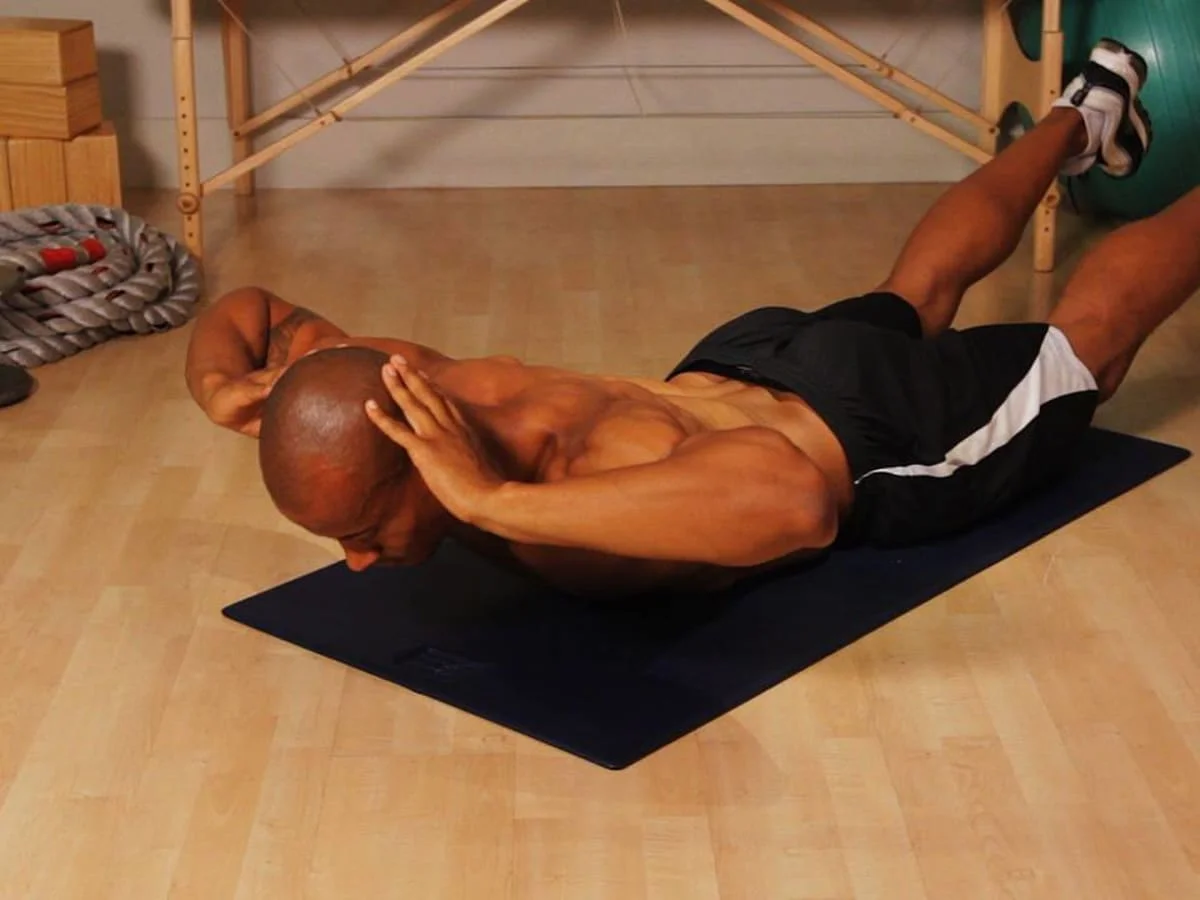
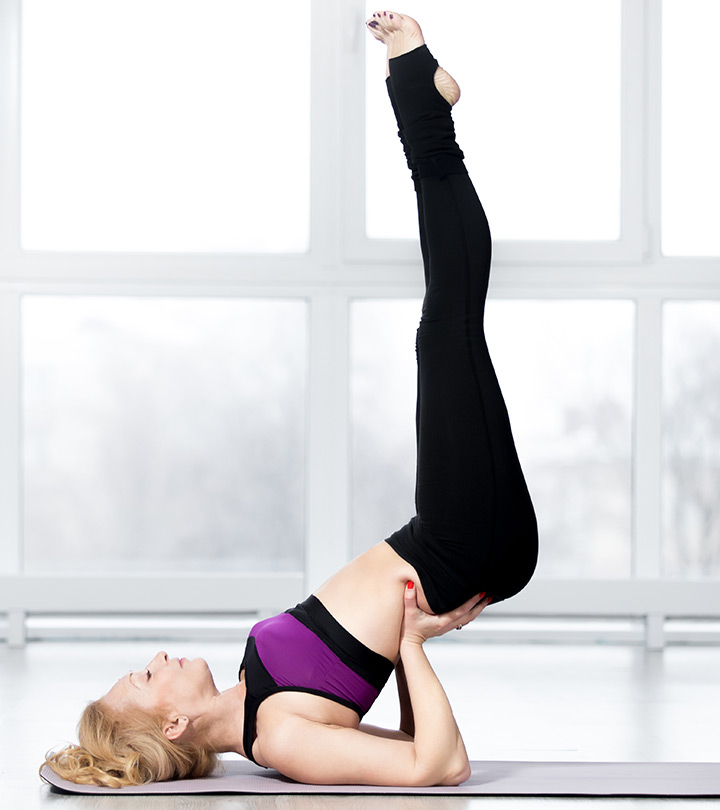
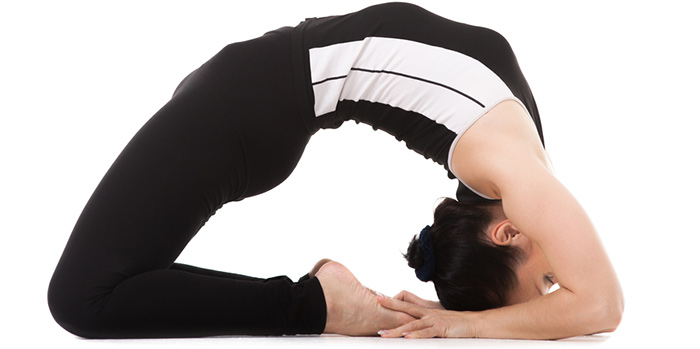

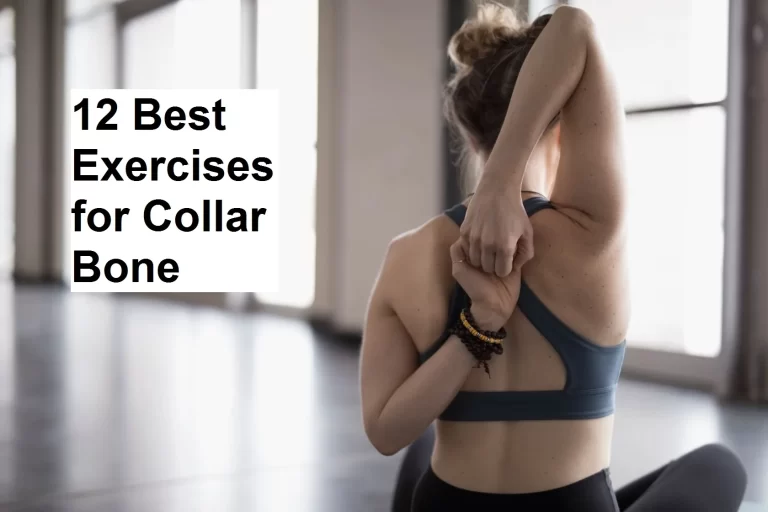
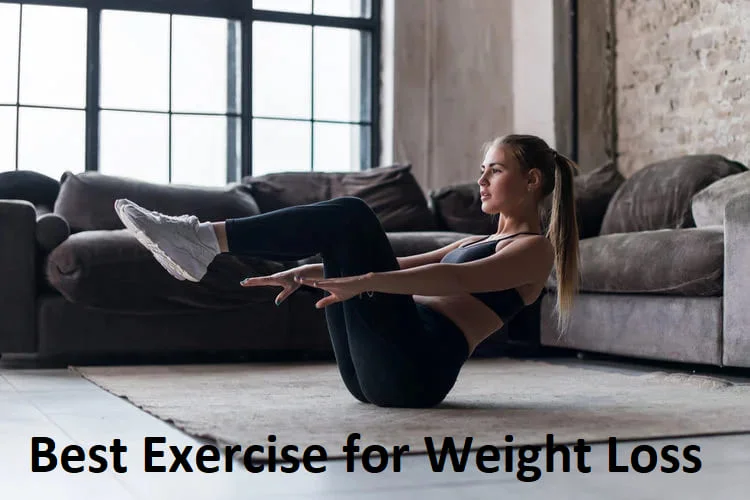

One Comment